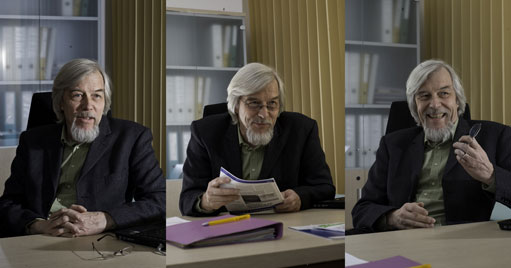
ATLAS e-News
23 February 2011
Address of the new Director General
26 January 2009

Faces of CERN's new Director General (courtesy of Maximilien Brice)
As citizens of the US pinned hope for change on their new leader, who also recently took office, many CERN users and staff are looking forward to what the new Director General will accomplish. Rolf-Dieter Heuer will not disappoint if his January 12th presentation is any indication. Professor Heuer’s administration proposed shared responsibilities, transparent decision-making policies inclusive to Users, and improvements in CERN’s ability to support the ever-increasing number of physicists.
Rolf Heuer opened by thanking Robert Aymar’s team for leaving CERN and the LHC in a good situation, with the completion of the LHC and a small amount of leeway in the budget. He makes a distinction between the construction that was underway until September and the repairs that are currently in progress. “The LHC is finished. It’s working, in principle,” said Rolf Heuer, “machine and detectors.”
He is changing the structure of the directorate, delegating responsibility to three directors: administration and infrastructure (Sigurd Lettow), research and computing (Sergio Bertolucci), and accelerators and technology (Steve Myers). While they form the core directorate, which will meet weekly, the heads of each department will also be included in biweekly meetings. A directorate office exists to support the work of the directors, and Rolf Heuer is making external relations a major priority with a dedicated group.
“The key word here is partnership,” said Rolf Heuer. Future accelerators to follow up the discoveries of the LHC will only be larger and more expensive. “Funding is not increasing,” he said, “to phrase it positively.” As large and complex as the LHC collaborations already are, future work will require even more cooperation and good will.
After the frustrating days and weeks following the September 19th damage to sector 3-4, when most of us were getting our LHC status updates from press releases and outside news articles, it is little wonder that the Rolf Heuer’s audience burst into spontaneous applause when, in his promise of fast and direct information flow, he said, “you’ll hear it from us and not from the press.” He pledges to give regular updates in a weekly bulletin.
Among scientific goals, naturally, LHC physics is priority number one. Both time and money are major constraints, and it will be a challenge to get high energy collisions this year. At least half of the magnets in the LHC need to stay cold during the shut-down period, and CERN must spend 30-40 million Swiss francs on the repair project. This year's goal is 10 TeV.
Rolf Heuer recognizes that in order to run this year, the accelerator team will have to compromise on what tests and safeguards they can make with the limited time and money. “I call it the minimum risk scenario because it’s clear, we cannot do everything,” he said. “We have to cut somewhere.” He also recognizes that whatever is decided at Chamonix in early February, when the accelerator team meets and revises the schedule, it will affect 2010 as well.
Other LHC-related initiatives include an Analysis Centre for LHC physics, for cooperation among all experiments and CERN staff, and a “green” Tier-0 building with a reduced carbon footprint. The SLHC and analogous experiment upgrades are in the research and development stage.
Rolf Heuer seeks to diversify CERN projects. During the peak years of LHC construction, no new smaller experiments were added to CERN’s repertoire. He mentioned both fixed target beams and collaboration with astroparticle physics in his address. CERN should also be prepared to make new project proposals shortly after LHC discoveries, since it will be easier to get funding while citizens and politicians are already thinking of advances in particle physics.
Finally, Rolf Heuer also has plans to address CERN’s growing infrastructure needs, since its role as a global centre for particle physics is continually growing. “The numbers keep going up – I don’t know where all these particle physicists are coming from,” he remarked in mock perplexity. An extension of building 40 is under construction, and a temporary auditorium in building 216 is nearly finished, seating 300, to accommodate the increasing number of users.
“Restaurant 1 is sometimes slightly crowded,” he observed, and most of us have experience with struggling to find empty chairs to seat a group larger than two or the impossibility of navigating the sea of elbows, backpacks, and trays in the main cafeteria. He would like to see this building extended as well, but money may prove a limiting factor in the short run.
“I am looking forward to working with you,” he closed to a roar of clapping hands. “Let’s see if I get the same applause at the end of the year.”

Katie McAlpineATLAS e-News |